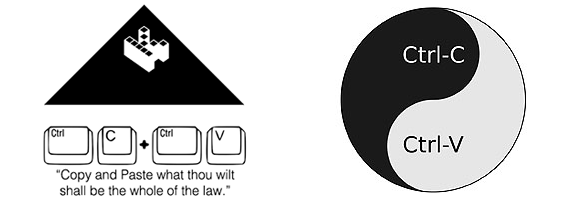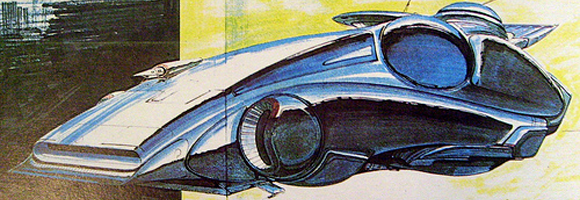
Oh, how I do like this—first ↑The Pirate Bay was a website tracking torrents, then a ↑political party sprouted from it, now there’s a religion. In Sweden ‘Det Missionerande Kopimistsamfundet’ (‘↑Missionary Church of Kopimism‘) is officially recognized as a religion since late December 2011. Especially I do embrace the reference to ↑Aleister Crowley via the slogan ‘Copy and Paste what thou wilt shall be the whole of the law.’ [all in all there are five chapters on Crowley [rhymes on holy] in my old book ‘↓Metatrickster‘ (2004)]
At last year’s biannual conference (14-17 September in Vienna, Austria) of the German Anthropological Association (GAA/DGV) the opening keynote was delivered by Brazilian anthropologist Gustavo Lins Ribeiro. It was called ‘What’s in a copy?’—you can listen to the complete keynote, including the introduction by André Gingrich and an interview with Ribeiro at ↑Talking Anthropology: ↑TA35—What’s in a copy. [And when you’re over there already, you can listen to me, too: ↑TA37—Cyberanthropology ;-]
Retroactively Ribeiro now has taken the role of a kind of John-the-Baptist prophet.
Now I wonder, if I convert to Kopimism, can I have it officially noted in my passport?
70
e-lectricity
In a small township on the outskirts of Johannesburg, South Africa, paraffin has become the currency for trade. However, a rising paraffin shortage is threatening to plummet the township into complete darkness. Walter Hlase, a shy and introverted inventor decides that if he can create a new renewable energy source, he will gain the respect and friendship of the townsfolk. But is this easier said than done?
who is jumping?
zeph’s pop culture quiz #11

Who is jumping? And where to? I saw the movie as a kid on TV and since then I take the scene to be one of the most hilarious moments in motion picture history. It’s as fine a piece of comedy as possible. Spiced with a huge load of self-irony.
Just leave a comment with your educated guess—you can ask for additional hints, too. [Leaving a comment is easy; just click the ‘Leave a comment’ at the end of the post and fill in the form. If it’s the first time you post a comment, it will be held for moderation. But I am constantly checking, and once I’ve approved a comment, your next ones won’t be held, but published immediately by the system.]
abandoned asylums

↑Environmental Graffiti carries a ↑collection of 34 photographies shot at 10 different abandoned and meanwhile decaying former mental institutions in Great Britain. The pictures are haunting and really give me the creeps. After viewing them you know that all the versions of ↵Arkham Asylum are not the products of imagination.

lolspeak thesis
That’s just wonderful and remembers me of ye ole days when I was still compiling a ↑dictionary of online lingo …
ABSTRACT: Lolspeak, which I characterize as an internet dialect of English that is used in conjunction with images of cats, exhibits distinctive variations and patterns which differ from those of standard English. Lolspeak has influenced other language use and may have a significant impact on the English language, due in part to the internet’s role in the evolution of English (Crystal “Language and the Internet,” 2006:26-27). To approach this data, I created a multi-modal discourse transcription technique for analyzing Lolspeak utterances within the context of their images based on Grounded Theory (Glaser and Strauss “The Discovery of Grounded Theory” 2007:9). I implemented this technique with randomly collected Lolspeak data that I collected from the website www.icanhascheezburger.com. My work has dual future implications in that it could be used to further studies of Lolspeak or other internet dialects/ languages, and the transcription method I have invented could be beneficial to those looking at other forms of multi-modal discourse.
orwellian documentaries
In the sidebar of his blog ↑Dialogic blogger Thivai Abhor maintains a nice list of documentary films which are available online. After having skimmed through a bit, my personal interests were most matched by the three shortly described below. But Dialogic also points to ↑Top Documentary Films, a blog reviewing, commenting, and linking to 1800+ documentary films, all available online, and ↑sorted into categories.
‘↑All Watched Over by Machines of Loving Grace‘ (Curtis 2011)
A series of films about how humans have been colonized by the machines they have built. Although we don’t realize it, the way we see everything in the world today is through the eyes of the computers. It claims that computers have failed to liberate us and instead have distorted and simplified our view of the world around us. […] (↑Top Documentary Films)
‘↑Iraq for Sale: The War Profiteers‘ (Greenwald 2006)
Documentary portraying the actions of U.S. corporate contractors in the U.S.-Iraq war. Interviews with employees and former employees of such companies as Halliburton, CACI, and KBR suggest that government cronyism is behind apparent “sweetheart” deals that give such contractors enormous freedom to profit from supplying support and material to American troops while providing little oversight. Survivors of employees who were killed discuss the claim that the companies cared more for profit than for the welfare of their own workers, and soldiers indicate that the quality of services provided is sub-standard and severely in contradiction to the comparatively huge profits being generated. Also depicted are the unsuccessful attempts by the filmmakers to get company spokesmen to respond to the charges made by the interviewees.
(↑Jim Beaver at IMDb)
‘↑Orwell Rolls in His Grave‘ (Pappas 2003)
The film examines the current and past relationships between the media, the US government and corporations, analyzing the possible consequences of the concentration of media ownership. Making references to George Orwell’s novel Nineteen Eighty-Four, the film argues that reality has met and in some ways exceeded Orwell’s expectations about a society dominated by thought control, which is made possible by the media. According to the film, the mass media no longer report news, but manage it, deciding what makes the headlines and what is conveniently ignored, thus ultimately defining the framework upon which most other issues are discussed by the society. As an example, it is claimed that since the late 1980s there’s been an agenda pursued by the major media corporations regarding the deregulation of the media market, by which news reports sell all its benefits while neglecting its disastrous results.
space battleship yamato

This is a moc [my own creation] ↑version of the Space Battleship Yamato by afol [adult fan of LEGO] ↑Mark Rodrigues. The original stems from the ↑franchise of the same name and is itself based on the Imperial Japanese Navy’s ↑Yamato class battleships which were in service during World War II. It’s neither steam- nor dieselpunk, of course, but retrofitted futurism for sure.

burns’ spinner

Most of the art in the wonderful ↵Blade Runner Sketchbook is by ‘visual futurist’ ↑Syd Mead, but I remembered that illustrator Jim Burns, whom, like Mead, I do admire since childhood, also did design work on ‘Blade Runner’ (Scott 1982). But his name is neither to be found in the sketchbook nor in the full cast and crew at IMDb. Now I found an ↑interview with Jim Burns which clears the matter up:
[Anthony Brockway:] You did a bit of work on the Blade Runner film back in the Eighties. What did that entail exactly?
Jim Burns: Here’s the story in brief. Ridley Scott got in touch via my agent. Early days in his film career, Alien under his belt and a new project gestating. That project was Dune. He saw my illustration for ‘Colonel Kylling’ in the joint book project Planet Story I did with the sf writer, Harry Harrison – and thought that this depiction was perfect for the Baron Vladimir Von Harkonnen character in Dune. Shortly before I was supposed to fly out to Hollywood and participate in early concept work on Dune – that project was shelved and Ridley Scott found himself instead with a script based on the novel by Philip K. Dick called Do Androids Dream of Electric Sheep. This of course became Blade Runner. The offer to go and work on early concept material for this new film was held open for me – and so I went over to Hollywood for ten weeks and found myself involved mostly on design work for the police spinner and the various city design details. The police spinner found it’s earliest incarnation in a machine I painted for a book a few years earlier called Tour of the Universe – actually a ‘flying ambulance’ in that story. Ridley turned the image upside down and said “Hey Presto – there’s the police spinner!” – or words to that effect. Eventually the hugely talented Syd Mead was taken on and he basically took on the look of the whole film – very successfully indeed. But I like to think that some germ of my original police spinner resides in the version you see on film!
anthropological lego friends

When students or other interested parties ask me what anthropologists could do outside academia, in the industry in particular, I maintain a threefold answer. In the industry anthropologists 1) do research on organizations—amounting to something like consultancy, 2) do market research, and 3) are participating in product design—especially user-centered design comes to mind. Well, as it seems anthropologists had a hand in the ↑meanwhile available new series LEGO friends, which triggered some ↑discussion on gendered toys. Businessweek has a ↑longer story on LEGO friends, and ↑Andrew wrote at ↑the brothers brick: ‘For those of you out there who’ve made statements about gender stereotyping, take a look at this photo of set 3933 Olivia’s Inventor’s Workshop: That’s right—Olivia has invented herself a robot in her laboratory through the use of math and science.’ [I of course chose the picture not for the gender-thing but for the robot—will recreate it in a second.]



